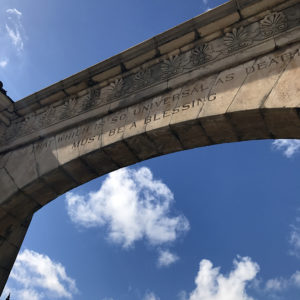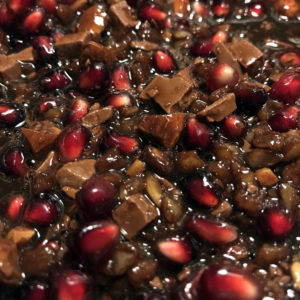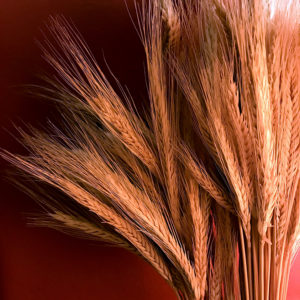Did you read the Convivio Dispatch for Halloween? The story, just slightly ghostly, was titled “That Which is So Universal,” and if you are subscribed to my Dispatches from Lake Worth, it would have arrived as a plain text email to your inbox on Halloween. If it did not, then it is either in your junk mail box, or you are not subscribed. If you are not and you’d like to be, just click here to do so. I’ll see that you get the story.
The archway in the photo above is the entry to Woodlawn Cemetery in West Palm Beach, where I was walking late this morning. Home now, but there is much to do to prepare for our Dia de Los Muertos celebration, which, for us this year, will be spread out over a few days. Tonight Seth and I will be together and we will remember our loved ones. Saturday, though, is the day we will get together with my mom and sister for more festivity, for it is the day of our annual Dia de Los Muertos celebration here in Lake Worth. My mom and sister and Seth and I will all be there, along with the mariachi and the dancers, the wonderful food, and all the people dressed as Catrinas and Calaveras. We’ll have a booth selling our traditional handicrafts from the artisans of San Miguel de Allende. It is an amazing night in our community, and I hope you can join us if you are nearby. Here is a link to the event’s webpage, and here is a link to the event’s Facebook event page. It all takes place at Hatch 1121 (the old Lake Worth Shuffleboard Courts) at 1121 Lucerne Avenue (between Lake and Lucerne just west of Dixie Highway) in Downtown Lake Worth. The music and the dancing and the food at this celebration are wonderful, but mostly it is the community that impresses me so much. Please come, and if you do, be sure to say hello.
Some more photos… here is a Pan de Muertos from La Villa Bakery in Boca Raton:
Our family version, for which I posted a recipe in yesterday’s chapter of the blog, looks a bit different. Ours is braided and long, not round, and the bones are always white, as we make sure to avoid sprinkling the sugar on them, and our sugar topping is actually a blend of cinnamon, sugar, and anise seeds. And then here is a photo of Cicci Cutto:
That’s a close up shot of the concoction, which is made from pomegranates, roasted almonds and hazelnuts, cooked wheat grain, and small chunks of chocolate, all swimming in an unusual homemade spiced syrup called cutto, traditionally made from grape juice reduced over a low flame for many hours. We call it U Cutto in our dialect from Lucera, and it is the subject of a book I made many years ago. Someone recently bought a copy and it was nice to get reacquainted with this work of mine from two decades ago. My mom and sister made the cicci cutto for Halloween two nights ago, but we were too full to eat it then, so we are saving it for Saturday’s gathering. In some parts of Italy it is made for December 13th: Santa Lucia’s Day, but my grandmother always made for this time of year, these autumnal days of the dead known in Italy as I Morti. It is a somewhat penitential dessert, something rich and complex that invites us to think about what we are eating and its connection to story and metaphor… especially that of Persephone and her pomegranate seeds and her yearly descent down below the earth. We follow in her footsteps at this time of increasing darkness.
And so we do these things we do just at this time of year, this time of increasing darkness, and we remember those who have come and gone before us. It is good, it is right, to do this, shining love and light across time and space and connecting us all.
¡Feliz dia de los muertos!



